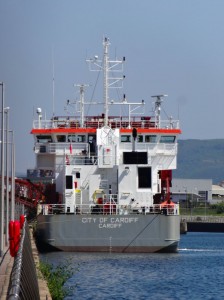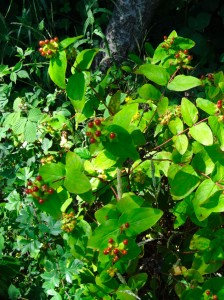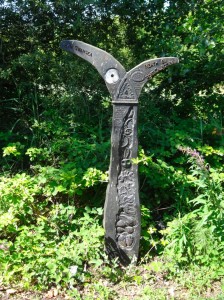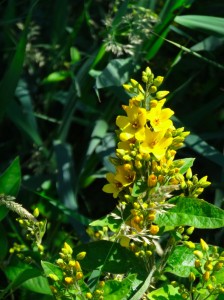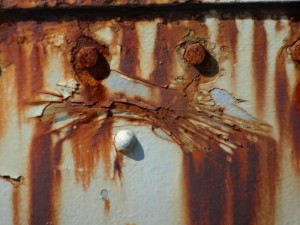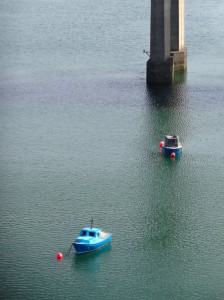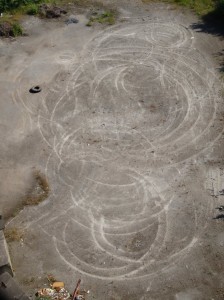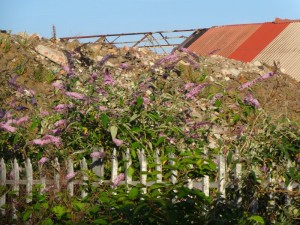surprised by nature behind the busy streets and Stallone on the waterside, faint childhood memories and grand hotels
19th July 2013
miles completed: 1002
miles to go: 56
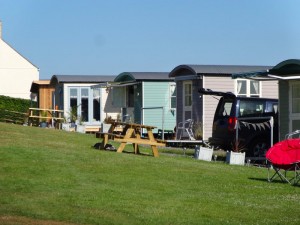 I get going early, but final moving on preparations always take a little longer than I plan: emptying the toilet, throwing out the rubbish, turning off electricity and gas, driving off and retrieving the levelling blocks, and generally putting things places they won’t fly off the first time the van turns a corner.
I get going early, but final moving on preparations always take a little longer than I plan: emptying the toilet, throwing out the rubbish, turning off electricity and gas, driving off and retrieving the levelling blocks, and generally putting things places they won’t fly off the first time the van turns a corner.
I had planned to be waiting outside the Three Cliffs Café at West Cliff at the stroke of nine, but it was in fact half past, not too badly delayed, when I got there, parked in the National Trust car park and went in for another breakfast.
I thought I’d asked for no cockle and laverbread parcels, but when the plate came they were there. The waitress helpfully got me a second plate, and I resolved to eat them first. The waitress suggested eating them with tomato ketchup. "That’s how I first learnt to eat them," she said.
I did one better and ate them with the cooked tomato, which is never my favourite item anyway, and I only say yes to as I know they are good for me. I was expecting some intense sea-food flavour, but in fact it was much more subtle, although not something I could eat quickly, especially with a fork in one hand and a computer in the other.
When I had been in the other day, the waiter had said that they had WiFi, and that it was fast. He had been true to his word: in all my journeys, I have never seen Flickr suck up photos so quickly. I was probably there an hour and half in the end, slowly eating my breakfast whilst uploading photos and blog entries, and in that time all my backlog of seven or eight days photos had been uploaded.
And so on, to Aberavon and the Best Western Beach Hotel, which appears to be the only beach-front accommodation. The TripAdvisor reports were almost all very positive, but all said, "better on the inside than it looked from the outside." The outside is a motley collection of rectangular 1970s yellow brick, lumps stuck together, with even the sign somewhat apologetically placed at a far corner of the property as if it were too ashamed to be placed closer.
Men in suits, women of sizeable proportions, in bright coloured dresses of various lengths and cuts, and a small girl in a long white lacy bridesmaid dress, rendered the signs saying ‘wedding breakfast’ almost redundant. The reception was also to be held in the hotel, and a sign warned that there may be some delays in service later due to a major function.
In fact, when I did get food there later, I noticed no delay, maybe because they had moved from eating to party mode by then. In general, the TripAdvisor reports are absolutely right, everyone in the hotel was very friendly and the service and food were good.
 I asked about buses to Swansea and was directed down the road to the Labour club, or to give it it’s full name ‘Seaside Social & Labour Club‘. The receptionist described it as a "big grey building", and I had imagined concrete, like a miniature version of the Swansea Civic Centre, but instead it is clad with grey coloured, sheet metal section that I would expect to see on the roof of an industrial warehouse. In a different location I would imagine it was a converted commercial building, but here, in the middle of a residential area, it must have been purpose built; I assume it was just the cheapest material at the time, or maybe even some sort of modernist cachet.
I asked about buses to Swansea and was directed down the road to the Labour club, or to give it it’s full name ‘Seaside Social & Labour Club‘. The receptionist described it as a "big grey building", and I had imagined concrete, like a miniature version of the Swansea Civic Centre, but instead it is clad with grey coloured, sheet metal section that I would expect to see on the roof of an industrial warehouse. In a different location I would imagine it was a converted commercial building, but here, in the middle of a residential area, it must have been purpose built; I assume it was just the cheapest material at the time, or maybe even some sort of modernist cachet.
Going back from the seafront towards the Labour club one is instantly in the land of budget supermarkets and council house estates, built to house the steel workers in the 1960s and 1970s. I’d guess many are privately owned nowadays.
The bus goes into the heart of Swansea, but has a stop virtually beside the Waterfront Premier Inn and its bar where I had stopped on Tuesday. Hot and sticky from the bus ride, I stop in the shade of the bar long enough to drink a half pint and iced water, and set off; it’s already 2:30 by this time.
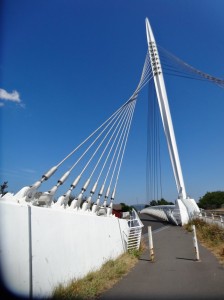 From the map, I was expecting a long walk through back streets and along the side of the main road, and indeed it started that way, before turning slightly away from the road (not well signed) past the park-and-ride car park (day parking only, otherwise it would have been a good place for walking from) and port area, with a McDonald’s and Ibis visible through the trees, then over the main road on a new (millennium?) footbridge, and then a few hundred yards of back streets, before setting off along a footpath that I assume may have once been some sort of small industrial roadway.
From the map, I was expecting a long walk through back streets and along the side of the main road, and indeed it started that way, before turning slightly away from the road (not well signed) past the park-and-ride car park (day parking only, otherwise it would have been a good place for walking from) and port area, with a McDonald’s and Ibis visible through the trees, then over the main road on a new (millennium?) footbridge, and then a few hundred yards of back streets, before setting off along a footpath that I assume may have once been some sort of small industrial roadway.
The vegetation is initially that wildlife rich scrubland, typical of mature waste ground, maybe cleared industrial ground or simply in-between.
There is the tree-muffled sound of traffic and the occasional faint, sweet yet acrid odour from the landfill, though the latter I would probably not have recognised if not for the large sign before I entered the path. But apart from these you could be anywhere deep in the countryside, and as the path progressed, moved further north from the road and no longer downwind of the landfill, even these faint traces disappear; so at first you are wandering through a woodland path, and then past wetlands, and then on an old canal-side path, but all on wide, well-made-up tarmac or gravel cycle paths. The occasional bicycle does pass me, but no other walkers.
At one point the canal is covered by a wide concrete structure, more like a 1970s veranda than a bridge, with only metal steps on the far side of the canal, and on my side, no access, simply continuing to my right until it joins a bank, and I assume continues as a wide concrete road on the higher ground beyond. Maybe this was some sort of loading/unloading point for the canal. A few pieces of broken brickwork litter the ground, I assume part of a long collapsed wall, but if so most of it has long since gone. On one piece, the size of a small table, is a blackened, fire-burnt patch as if it were an altar to the god of lost places.
Soon after this the path does join the road, first a minor road for a mile, past a hotel called ‘The Towers‘ with a red brick windowed tower in its grounds. Without the windows I would have thought it a Victorian water tower, but as it is, maybe simply a folly.
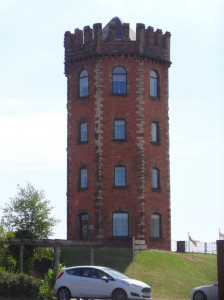 At the end of this road is a large roundabout and you follow the footpath along the main A48. Almost instantly there is a road sign telling the cars that the turnoff for the M4 is in 1/2 mile, and I know the bridge I will cross is only a little further, but it is a long half mile and then perhaps another half mile beyond that to the bridge itself.
At the end of this road is a large roundabout and you follow the footpath along the main A48. Almost instantly there is a road sign telling the cars that the turnoff for the M4 is in 1/2 mile, and I know the bridge I will cross is only a little further, but it is a long half mile and then perhaps another half mile beyond that to the bridge itself.
Before getting to the turnoff there is a layby and in it a solar powered rubbish bin. Yes, really. The power of ‘BigBelly Solar‘ is used to compact the rubbish, a perfect use of solar power, heavily geared (whether physical or electronic I don’t know) to generate high pressure but very slowly, meaning the bin does not have to be emptied as often, saving energy in driving a van to collect it. But I guess there is an alternative narrative, of technology replacing the labour of the bin-men.
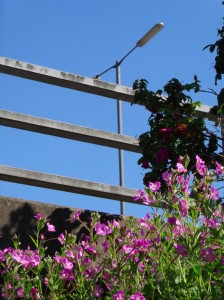 As the M4 turn-off approaches, there are the usual countdown signs, but for some reason just ‘III’ and ‘I’, the two-hundred-yard sign is missing. Just before I would need to cross the slip lane there is an underpass taking me to the other side of the road with spectacular views of the underside of the flyovers leading to the motorway bridge, a forest of concrete trunks, and a sign to the 6th and 14th Tee of a golf course that is divided by the A48.
As the M4 turn-off approaches, there are the usual countdown signs, but for some reason just ‘III’ and ‘I’, the two-hundred-yard sign is missing. Just before I would need to cross the slip lane there is an underpass taking me to the other side of the road with spectacular views of the underside of the flyovers leading to the motorway bridge, a forest of concrete trunks, and a sign to the 6th and 14th Tee of a golf course that is divided by the A48.
Passing under the motorway bridge is wonderful, a few moments’ shade from the sun.
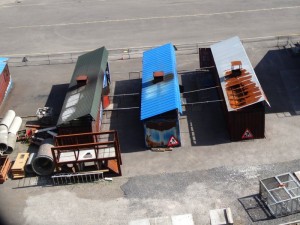 The A48 bridge is not in the same league as the Severn Bridge, but does give views over the River Neath both upstream towards the hills of the Neath Valley and downstream past industrial buildings, power station, recycling centre and the old, disused docks. The docks were evidently another creation of Brunel and included a ‘floating lock’ with an unusual hydraulic mechanism that you pass further towards the sea. There are attempts to preserve and restore this unique piece of industrial heritage.
The A48 bridge is not in the same league as the Severn Bridge, but does give views over the River Neath both upstream towards the hills of the Neath Valley and downstream past industrial buildings, power station, recycling centre and the old, disused docks. The docks were evidently another creation of Brunel and included a ‘floating lock’ with an unusual hydraulic mechanism that you pass further towards the sea. There are attempts to preserve and restore this unique piece of industrial heritage.
The turn-off to go along the river is at a roundabout, where there is a choice, either to go along the river to the sea and Aberavon prom, or a ‘high level route’ that bypasses Aberavon and Port Talbot. The latter is the ‘scenic’ route, but I have found that I learn more as the Coast Path travels close to people, with all the industrial and residential messiness that this brings with it. The signposting at the roundabout shows both routes, but is very confusing; I am glad of the map, as I turn past the industrial area towards the river bank.
I pass a Stallone-like figure, bare torso and chest like steel plates, with a dark dog, like an Alsatian, but more snub-nosed. As I go on the dog follows me and comes round. I offer it the backs of my fist-clenched hands to smell. I should note that the fists are there not to hit the dog, but because you don’t want to offer fingers anywhere near the teeth of a dog you don’t know. I talk to him and his eyes look inquisitive and friendly. The man vainly calls the dog back, and eventually it responds. He explains that it is an Alsatian/Rottweiler cross and some people find it frightening, but it is really very gentle. This was clear, although maybe the fear is not totally misplaced, as it turns out it is also a guard dog, and is a very different creature if an intruder tries to come into its guarded territory after dark.
 I keep getting ahead a bit, and then stop to take a photograph, and the dog follows me again, so eventually it seems easier to keep pace with them and chat.
I keep getting ahead a bit, and then stop to take a photograph, and the dog follows me again, so eventually it seems easier to keep pace with them and chat.
Every so often the man stretches one side of his square jawed head, just like that gesture fighters make in films when they have taken a punch and are about to hit back, and again just like a mannerism I am sure I have seen Stallone use in films … does Stallone have a brother?
He also has two Japanese dogs, I forget the breed, but of a kind that are more frightening than an Alsatian/Rottweiler cross. They have been left behind at the site where he is working. He is taking the chance to walk the dog as from Friday when people leave work until they arrive back on Monday morning he is alone on the site and cannot leave.
 I assume you need to be a little tough to do this sort of work, but I didn’t know how tough. He said he had been firebombed and had dangerous dogs thrown over the fence into the compound with him, in an attempt to drive away security and leave the area unprotected. And yet, he also said that the reason he had taken this job was that he had been in corporate sales and was looking for something less stressful.
I assume you need to be a little tough to do this sort of work, but I didn’t know how tough. He said he had been firebombed and had dangerous dogs thrown over the fence into the compound with him, in an attempt to drive away security and leave the area unprotected. And yet, he also said that the reason he had taken this job was that he had been in corporate sales and was looking for something less stressful.
 After a while he turns round to go back, and I realise that in walking along the riverside with him, I’d missed the place where I have to turn off to go closer to the power station and skirt the marshes. My guess is that I could have continued along the nicely laid out River Path, and made my way round the point at the end onto the beach, but I wasn’t sure, so I backtracked and followed the Coast Path directions, past the power point, under the long runs of pipes to and from the river that had ‘Live Water’ written on them. It sounds like some Marvel comics character, or maybe a horror film, where the very water rises up into animate shapes.
After a while he turns round to go back, and I realise that in walking along the riverside with him, I’d missed the place where I have to turn off to go closer to the power station and skirt the marshes. My guess is that I could have continued along the nicely laid out River Path, and made my way round the point at the end onto the beach, but I wasn’t sure, so I backtracked and followed the Coast Path directions, past the power point, under the long runs of pipes to and from the river that had ‘Live Water’ written on them. It sounds like some Marvel comics character, or maybe a horror film, where the very water rises up into animate shapes.
As the path heads towards the sea, there is an empty area to the left that is heavily fenced, including a barbed wire roll on the inside. At first it almost seems as if they are trying to keep something in, but I guess this is just to discourage people from climbing over and jumping down. I spot a place further on where one of the top strands of barbed wire on top of the fence has been cut, so the security here, just like the site Stallone is protecting, is clearly very necessary.
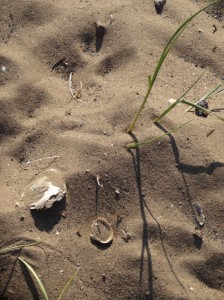 After this the path reaches the sand, which is thick with broken shells that prick if they find their way under my toes. I am glad that I am not barefoot, the exposed sand has absorbed the full day’s sun, so that, even with sandals on, the soft dry sand splashes over my bare toes, like covering a jacket potato with fire embers. But it was just one storm-blown dune, and then dropped into the wide beach beyond.
After this the path reaches the sand, which is thick with broken shells that prick if they find their way under my toes. I am glad that I am not barefoot, the exposed sand has absorbed the full day’s sun, so that, even with sandals on, the soft dry sand splashes over my bare toes, like covering a jacket potato with fire embers. But it was just one storm-blown dune, and then dropped into the wide beach beyond.
The beach stretches, dune backed and virtually deserted, for about two miles and then there is another mile of promenade before the breakwater of Port Talbot docks. However, there’s a slight curve, near the mouth of the Neath, so the first views are simply endless sea and sky ahead with Swansea and the Gower stretched out behind.
After a while the three huge cranes of Port Talbot dock appear, and also the smaller cranes working on improvements to the Avon Lido.
I had expected Aberavon to feel like one of those run-down seaside resorts that I had seen on the north coast. However, there has been a regeneration project. Brand new white railings line the promenade and there are new playgrounds and soft red brick ice cream shops, as well as sunken gardens and more substantial entertainment buildings.
However, the Beach Hotel, where I am staying, appears to be the only accommodation on the sea front. Behind the promenade there is a sea of council housing, none of the Georgian spa or Victorian railway destination villas that characterise so many seaside towns. This has always been a day trip resort, for the steel workers and maybe Neath Valley miners, and I guess was maybe simply open dunes until the estates were built in the 1960s or 1970s.
 I recall once or maybe twice going as a child to Aberavon, past the sulphurous towers of Port Talbot, but I recall nothing of the beach itself. When I see signs for Aberavon Lido, the ‘Lido’ is familiar, so maybe it was here that we went, I am guessing a vast paddling pool with seating beside. I also recall that we asked to go back, but rarely, if ever returned.
I recall once or maybe twice going as a child to Aberavon, past the sulphurous towers of Port Talbot, but I recall nothing of the beach itself. When I see signs for Aberavon Lido, the ‘Lido’ is familiar, so maybe it was here that we went, I am guessing a vast paddling pool with seating beside. I also recall that we asked to go back, but rarely, if ever returned.
Maybe the lack of 19th century seaside boarding houses has been a blessing, otherwise Aberavon could have become the B&B overspill for ‘problem families’ from Swansea and Cardiff as Rhyl has become for Liverpool.
 I pass the Beach Hotel and am wondering whether to stop there, my original plan, or to push on to Port Talbot station, which I assume will be easiest to come back to from Porthcawl the next day. I am about to go in to have a quick break, but then realise that if I do so I will definitely not go further, so press on along the rest of the seafront.
I pass the Beach Hotel and am wondering whether to stop there, my original plan, or to push on to Port Talbot station, which I assume will be easiest to come back to from Porthcawl the next day. I am about to go in to have a quick break, but then realise that if I do so I will definitely not go further, so press on along the rest of the seafront.
Towards the river and breakwater there is seafront residential development. In some ways similar to Llanelli‘s coast park ‘executive’ estates, or Swansea‘s marina-side quarter, but under the shadow of Tata‘s smoking stacks, this will never be a gentrified area; instead these seem to be family homes, with stair gates over open front doors, and front garden barbecues, very un-middle class.
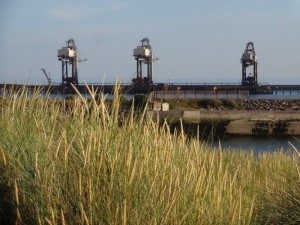 In front of the new housing is a smaller beach, between the breakwater and the river, with just a gravel bar separating the dredged river mouth and harbour entrance from the beach.
In front of the new housing is a smaller beach, between the breakwater and the river, with just a gravel bar separating the dredged river mouth and harbour entrance from the beach.
The Coast Path follows the riverbank upstream, past the harbour mouth with old wooden structures that I assume were once wharfs, naked in the stream. In fact I am unsure whether the old docks are active at all, as the steelworks cranes are on a pontoon in a new harbour between larger breakwaters south of the river.
 In the low-tide mud of the river bank are brightly coloured fishing boats, and one that is clearly no longer watertight and has taken on the green and grey of the mud, camouflaged against the wooden wharf side.
In the low-tide mud of the river bank are brightly coloured fishing boats, and one that is clearly no longer watertight and has taken on the green and grey of the mud, camouflaged against the wooden wharf side.
Stepping over a desiccated rat on the path and passing a wooden weir I come to a lovely old bridge, red rusted and perforated, almost lace-like, in places. A stone declares that it was erected by the Aberavon Corporation in 1903 and would once have been busy with traffic, but now is a quiet footbridge with views downstream to the old dockyard lock and upstream to the hills beside the Afan Valley.
I guess in crossing the bridge I move from Aberavon to Port Talbot.
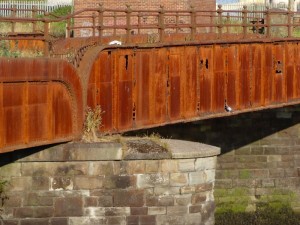

Slightly further upstream, walking along the southern bank of the Afan, there is a roundabout crossed by a footbridge, and then a further walk along the river bank past a concrete weir with a high-level canal-like channel, which I guess fills the docks, and maybe did act as a canal for barges going upriver into the town.
While not as rural feeling as the path between Swansea and the Neath bridges, still the lush vegetation, wild flowers and water give this in-between place a touch of magic.
An underpass takes the path into a lane running behind the railway line. On the right a taxi is dropping someone at a fitness club, and if I were closer I would probably get a number, as it is getting late now and I am suddenly tired, not to mention hungry, so hoping I don’t have to walk back to Aberavon beach, albeit, when I check afterwards on the map, little more than a mile away. As I get to the far side of Port Talbot station, a train pulls up, and I hurry along as I expect that taxis may come to meet the train. The railway staff club is on this side of the tracks, but I have to cross on a level crossing just beyond the station and come back to it from the far side.
 A taxi is just leaving and when I ask tells me that more will come soon, so I join a short queue, and can start to contemplate Port Talbot itself, a town I have driven past many times, and I guess as a child I will have driven through in the days before the M4, but certainly never before, to my memory, stopped at. It is certainly down at heel, but in a well-used way, not the sense of dangerousness of Connah’s Quay in the North. I guess here the steelworks are still a big employer, so this is still a live industrial town, not prosperous, but surviving. It is no wonder that Tata have a strong hold on the local council.
A taxi is just leaving and when I ask tells me that more will come soon, so I join a short queue, and can start to contemplate Port Talbot itself, a town I have driven past many times, and I guess as a child I will have driven through in the days before the M4, but certainly never before, to my memory, stopped at. It is certainly down at heel, but in a well-used way, not the sense of dangerousness of Connah’s Quay in the North. I guess here the steelworks are still a big employer, so this is still a live industrial town, not prosperous, but surviving. It is no wonder that Tata have a strong hold on the local council.
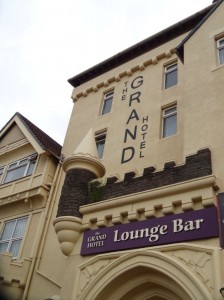 Opposite the station is the Grand Hotel. I can’t help myself hearing Greta Garbo‘s voice, "I want to be alone", in the 1932 film Grand Hotel. This Grand Hotel was never as grand as the one in Berlin, but clearly would have had its day when South Wales was the heart of world commerce.
Opposite the station is the Grand Hotel. I can’t help myself hearing Greta Garbo‘s voice, "I want to be alone", in the 1932 film Grand Hotel. This Grand Hotel was never as grand as the one in Berlin, but clearly would have had its day when South Wales was the heart of world commerce.
Back at the Aberavon Best Western Beach Hotel, it is clearly no Grand Hotel, and I can hear the wedding party in full swing. I was going to pop round the corner for fish and chips and maybe sneak them in my rucksack in case they didn’t like you to bring takeaways into the hotel. However, I look at the bar menu and the fish and chips are hardly more than takeaway prices, so I order there to take back to my room and lazily watch television while I upload from my camera and attempt, but fail, to use the WiFi during the breaks. Here the WiFi has a strong signal, and gives me an IP address, but never gets fully through to the internet. I could ring and ask them to fix it, probably a router needs rebooting somewhere, but I will be in Swansea University on Monday, so it doesn’t seem worth it, and instead I fitfully fall asleep as the day’s heat very slowly subsides and the sound of revelry continues late into the night.

